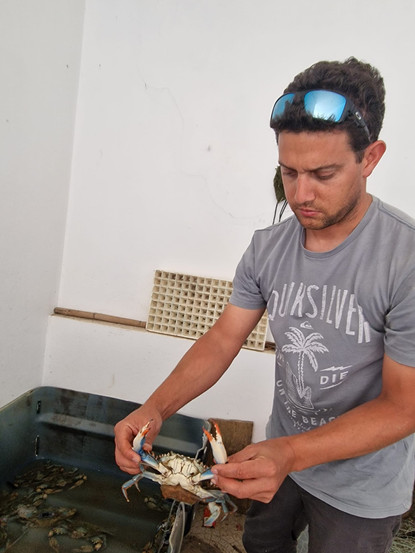Blue crab: Acoustic telemetry study
- NEMAlgarve

- Aug 22, 2022
- 2 min read

The blue crab "Callinectes sapidus" first appeared in the Algarve in 2016 in the Ria Formosa and since then has been increasing exponentially in abundance and geographical distribution. According to work carried out in its native area (Western Atlantic), during the breeding season the females move downstream from the estuaries to more saline coastal areas to spawn. The larvae remain a few weeks at sea, where they effectively require more saline conditions in the early stages of development. After turning into a mini blue crab, the larvae settle already in the megalopa stage. Then the juveniles move up the estuaries to brackish areas, and can even be found in areas of very low salinity. When they reach adulthood, and after some shell molts, the species migrates again to lower areas of the estuaries and coastal zone, repeating this cycle. The life cycle and migrations of this invasive species make its management even more difficult, as it occupies different ecosystems throughout its life cycle.
Acoustic telemetry has already helped answer several scientific questions in aquatic environments related to movements of species, from white sharks, turtles, meagres, salmon, etc. A passive acoustic telemetry system consists of two types of equipment:
1) The transmitters that are placed on the animals and transmit a radio signal with a certain signal code that allows the various tagged individuals to be distinguished;

2) Acoustic receivers, which are like underwater microphones and record the signals emitted by the transmitters. Naturally, the detection range is limited, depending on various factors, such as the location and form of installation, water turbidity, etc. Therefore, the larger the network of receivers, the better the detection capacity of the telemetry network.

The study started with the installation of two acoustic receivers in the middle Guadiana estuary at the beginning of May 2022, followed by the tagging campaign between June and August. Each crab is equipped with a small transmitter that will be detected by the various receivers installed along the Guadiana estuary and the Algarve coast. The blue crab, like any other crab, periodically changes its shell to allow for growth, so the installation of this small equipment does not affect the well-being of each individual. The information collected will allow us to know where these crabs live and for how long they live in each habitat so that we can propose more effective management measures to control this invasive species. Although the recapture of these crabs by amateur or professional fishermen is unlikely, please contact us by the telephone number on the tag attached to the crab, or by the contact details of the NEMAlgarve citizen science campaign (https://en.nemalgarve.com/contactos).
Special thanks to Ricardo Gonçalves, for his help in capturing some of the blue crabs used. This study is financially supported by the transboundary project ATLAZUL (www.atlazul.eu)






















Comments